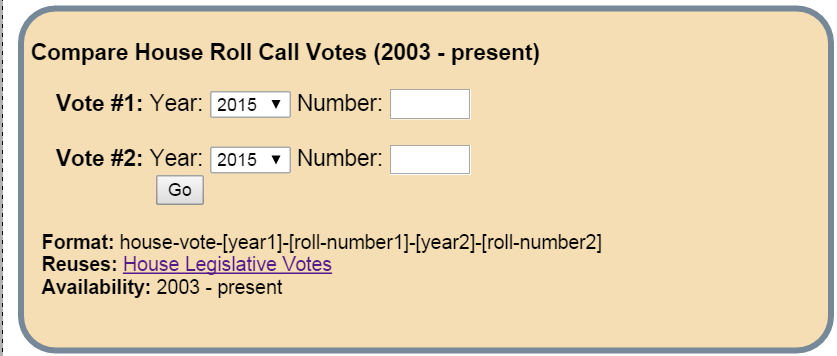The indefatigable Joe Carmel, creator of LegisLink, just unveiled a new tool for comparison of House Roll Call Votes. Drawing on a combination of official source material and prior work by Josh Tauberer (of GovTrack fame), the Roll Call Comparison Tool allows the easy comparison of two roll call votes, even if they don’t take place in the same session of Congress.
Why is this important? Often times, congressional staff and advocates compare multiple votes to identify strong supporters or opponents of legislation, or figure out where a new vote is likely to come out. This work is often done by hand and can take an hour to complete per comparison. This new tool makes it instantaneous. His work was prompted by the Congressional Data Coalition’s new list of congressional civic technology tools that should be built.
There are two ways to compare votes. The first is to go to a handy web-form, available here, and select the year each vote took place and its vote number.

If you don’t know which votes you want to compare off hand, you can do some digging on the Clerk’s website or through Congress.gov. The second is to type the comparison directly into your browser. It follow the format: http://legislink.org/us/house-vote-year–number–year–number, and looks like this: http://legislink.org/us/house-vote-2015-23-2014-34.
The results display first a summary of the two bills, and then a sortable list of the member votes. If you squint, here is what the summary looks like.
The sortable list, posted below the summary, includes the member last name, party, state, vote on the first bill, vote on the second bill, and a comparison of the two votes. The comparison will say whether they voted yes on both bill, no on both bills, had a mixed vote (yes on one, no on the other), or the information is not available (perhaps did not vote on one of the bills.) Here is what it looks like.
The data is also downloadable as a CSV or XML (and includes nifty information like bioguide IDs). Currently the website goes back to 2003, but soon it will go back to the 1990s. And, for the moment, the tool only compares House roll call votes, but the same principles should apply to the Senate.
All in all, this should save a ton of time and it’s a neat little project. Check out the site for full details.


